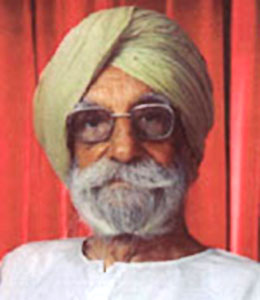 Sant Singh Sekhon was an extraordinary Punjabi author. Born in 1908 he altogether authored five collections of short stories, four of one-act drama, two novels, ten full-length plays, five books of literary criticism, two volumes of historical evaluation, and many translations to his credit. His creative force found its best expression in the fields of short fiction and drama. In recognition of his work, Punjabi University in Patiala made him Professor of Eminence and, after he died, set up a Chair in his name.
Sant Singh Sekhon was an extraordinary Punjabi author. Born in 1908 he altogether authored five collections of short stories, four of one-act drama, two novels, ten full-length plays, five books of literary criticism, two volumes of historical evaluation, and many translations to his credit. His creative force found its best expression in the fields of short fiction and drama. In recognition of his work, Punjabi University in Patiala made him Professor of Eminence and, after he died, set up a Chair in his name.
Sant Singh Sekhon was an experienced author. His first collection of one-act plays namely Chhe Ghar i.e. `Six Homes` in 1941 established this genre in Punjabi theatre. Tapia Kyon Khapia or `Why the Ascetic Got Confused` (1950), Natsunehe or `Dramatic Messages` (1954) and Sundrepad or `Beautiful Feet` (1956) followed its stride. With incidents drawn both from past and present, from rural and urban life, his one-act scripts come up with such original insights as tend to erode biases blocking the mind. Written chiefly in the ironic mode, they attain their end through dialogue, nuanced and scintillating at the same time. Apart from Wiaholi or `Bride` and Baba bohar or `Old Oak` in verse, all are in prose.
Sant Singh Sekhon was at his philosophical best in full-length drama. Drawn from ancient Indian mythology, Kalakar i.e. `Artist` in 1945 and Nal-Damayanti i.e. `Nala and Damayanti` in I960 focus on the relationship between man and woman. The changes it has registered with growth of civilisation, the role that art plays in imparting it veracity and the moral responsibility entailed in artistic creation. Originally written as Eve at Bay in English, Narki or `Denizens of Hell` in 1953 is an expanded version in Punjabi. Here the sexual urge is shown negotiating with life`s economic reality.
The five historical plays namely Moian Sar Na Kai or `The Dead Knew It Not` in 1954, Bera Bandh Na Sakio or `Fleet They Could Not Harness` in 1954, Waris in 1955, Banda Bahadur in 1985, and Vada Ghalughara i.e. `Holocaust` in 1986 not only reinterpret Sikh history but also impart materialist moorings to its teleology. The Sahitya Akademi Award- winning Mittarpiara or `Beloved Friend` in 1971 depicts Indian, particularly Sikh, patriots striking an ideological affinity with Lenin to liberate India from British rule. Sant Singh Sekhon died in 1997.




